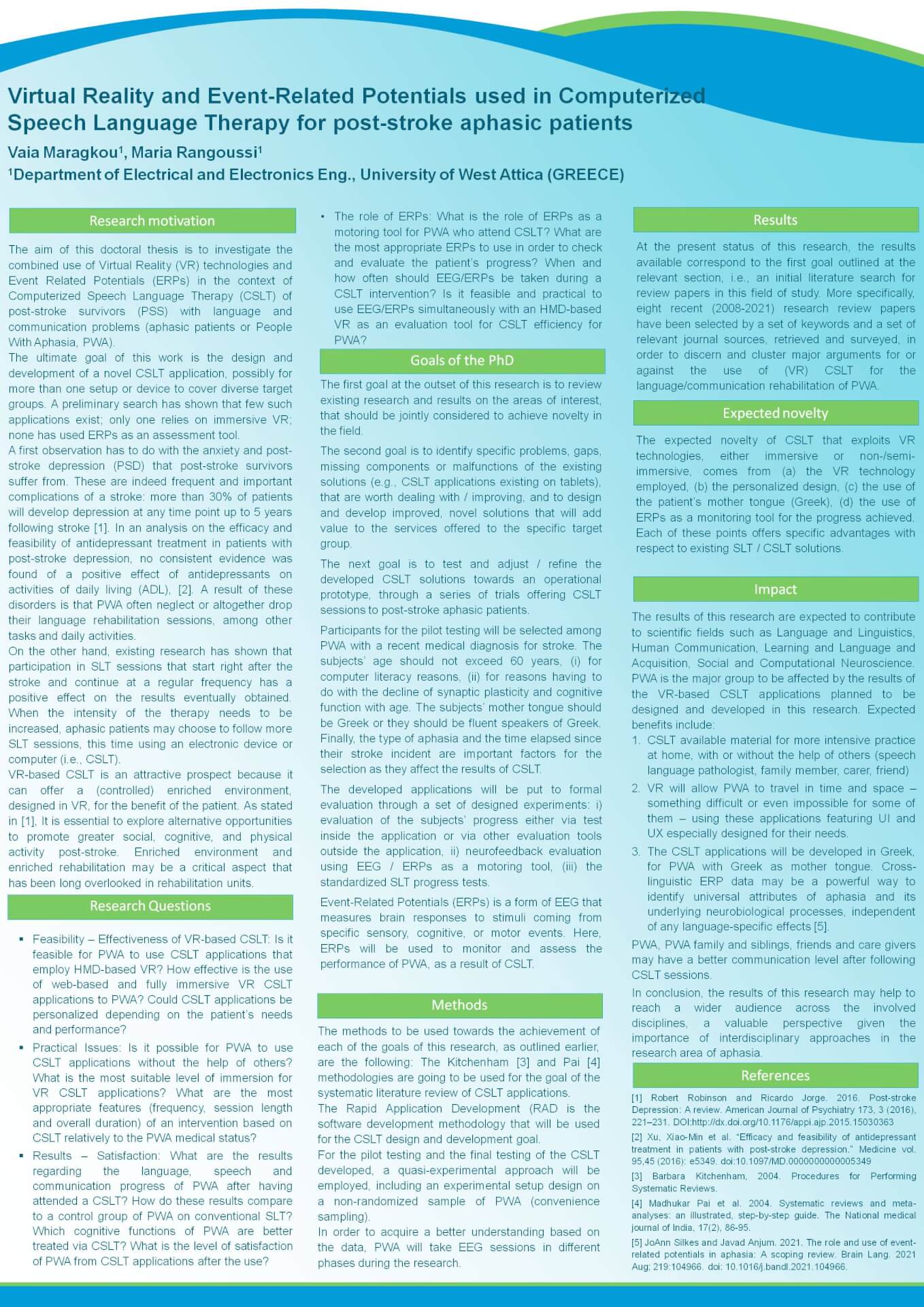The aim of this doctoral thesis is to investigate the combined use of Virtual Reality (VR) technologies and Event Related Potentials (ERPs) in the context of Computerized Speech Language Therapy (CSLT) of post-stroke survivors (PSS) with language and communication problems (aphasic patients or People With Aphasia, PWA).The ultimate goal is the design and development of a novel CSLT application to cover diverse target groups. A preliminary search has shown that few such applications exist; only one relies on immersive VR; none has used ERPs as an assessment tool.
Anxiety and post-stroke depression are frequent and severe complications of a stroke: more than 30% of patients will develop depression in the first 5 years after the stroke. As a result, PWA often neglect or altogether drop their language rehabilitation sessions. On the other hand, existing research has shown that SLT sessions starting right after the stroke and continuing at a regular frequency do have a positive effect on the eventual results. When the intensity of the therapy needs to be increased, aphasic patients may choose to follow more SLT sessions, this time using an electronic device or computer (CSLT). VR-based CSLT is attractive because it can offer a (controlled) enriched environment for therapy: this may be a critical aspect for rehabilitation.
Consequently, the following Research Questions (RQ) will be addressed:
- Is it feasible for PWA to use CSLT applications that employ HMD-based VR? How effective is the use of web-based and fully immersive VR CSLT applications to PWA? Could CSLT applications be personalized?
- Is it possible for PWA to use CSLT applications without the help of others? What is the most suitable level of immersion for VR CSLT applications? What are the most appropriate parameters of an intervention based on CSLT?
- What are the results regarding the language, speech and communication progress of PWA after having attended a CSLT? How do these results compare to a control group of PWA on conventional SLT? Which cognitive functions of PWA are better treated via CSLT? What is the level of satisfaction of PWA from CSLT applications after the use?
- What is the role of ERPs as a motoring tool for PWA who attend CSLT? What are the most appropriate ERPs to use? When and how often should EEG/ERPs be taken during a CSLT intervention?
Research steps to answer these RQs are (i) to review existing research and results, (ii) to identify specific problems, gaps, missing components or malfunctions of the existing CSLT solutions, (iii) to design and develop improved, novel solutions that will add value to the services offered (web-based and fully immersive, HMD-based VR), (iv) to pilot test and adjust/refine the developed CSLT solutions towards an operational prototype, through a series of CSLT sessions, (v) to formally evaluate the prototypes through a set of designed experiments: 1) evaluation of the subjects’ progress either via test inside the application or via other evaluation tools outside the application, 2) neurofeedback evaluation using EEG / ERPs as a motoring tool, 3) the standardized SLT progress tests.
In an initial literature search for review papers in this field of study, eight recent (2008-2021) research review papers have been selected via a set of keywords and relevant journal sources, retrieved and surveyed, in order to discern and cluster major arguments for or against the use of (VR) CSLT for the language/communication rehabilitation of PWA.
The expected novelty of VR-based CSLT, either immersive or non-/semi-immersive, comes from (a) the VR technology employed, (b) the personalized design, (c) the use of the patient’s mother tongue (Greek), (d) the use of ERPs as a monitoring tool for the progress achieved.
The results of this research are expected to contribute to all related scientific fields. PWA is the major group to be affected by the results of the VR-based CSLT applications to be developed. PWA, their family and siblings, friends and care givers may get a better communication level after following CSLΤ sessions. Researchers on brain waves and ERPs may also benefit from the results, e.g., benefit from the data collected on PWA brain and its response to the VR-based CLST sessions – especially in the damaged areas. VR and computer application developers and designers may add usability features to their products to address the needs of people with a wide range of disabilities. In conclusion, the results of this research may help to reach a wider audience across the involved disciplines, a valuable perspective given the importance of interdisciplinary approaches in the research area of aphasia.

